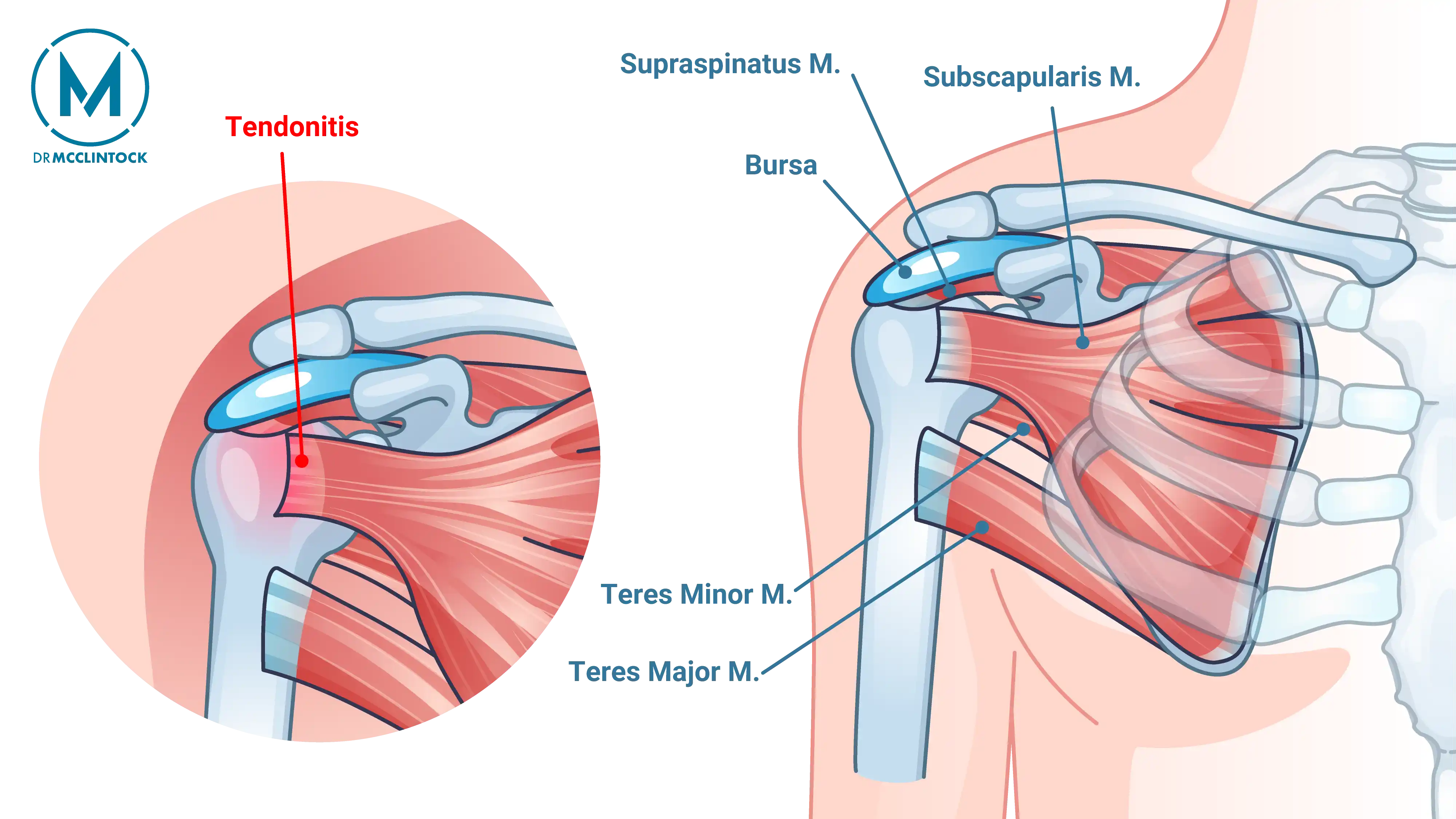Rotator cuff tendinitis causes shoulder pain and restricts arm movement. Often resulting from repetitive motions or aging, this condition can significantly impact daily life. In this post, we’ll explain the causes, symptoms, and treatments to help you manage and alleviate discomfort.
Key Takeaways
- Rotator cuff tendinitis, caused by inflammation of the shoulder tendons, often leads to pain and limited mobility. Early recognition and treatment are necessary to prevent complications.
- Non-surgical treatments, including rest, cold therapy, NSAIDs, and physical therapy, are effective for most patients, while surgery may be considered if conservative measures fail after several months.
- Preventive measures such as proper warm-up routines, minimizing repetitive overhead activity, and engaging in muscle-strengthening exercises are crucial for maintaining shoulder health and avoiding future injuries.
Understanding Rotator Cuff Tendinitis
Rotator cuff tendinitis is the inflammation of the key tendons in the shoulder. This inflammation often causes pain, particularly when raising your arm or performing overhead activities, and may lead to limited range of motion.
The rotator cuff consists of a group of four muscles and their tendons, which stabilize the shoulder joint and enable a wide range of movements.

The primary causes include repetitive stress, overuse, or age-related wear, which irritate and inflame the tendons. Over time, chronic inflammation can weaken the tendons, increasing tear risk. Patients typically experience persistent shoulder pain, especially when lifting the arm, and a noticeable decrease in shoulder mobility.
Early diagnosis and intervention are important in halting progression to more severe damage. A proactive approach to managing shoulder health can make a significant difference in maintaining an active and pain-free lifestyle.
Causes of Rotator Cuff Tendinitis
Rotator cuff tendinitis develops through various mechanisms, with age-related changes in the rotator cuff tendons being a significant contributor. As we grow older, vascular changes in the rotator cuff tissue may occur, increasing susceptibility to injury. These changes also reduce joint stability over time, making the shoulder more prone to tendinitis and other related issues.
Acute rotator cuff tendinitis can follow direct shoulder trauma, such as falls onto an outstretched arm or improper throwing techniques used in sports. In contrast, chronic tendonitis often stems from repetitive overhead activities or the physical demands of certain sports that cause continuous strain on the shoulder. Activities like swimming, tennis, or weightlifting, which involve continuous shoulder stress, can contribute to the gradual wear and tear of the tendons.
The anatomical structure of the acromion (the summit of the shoulder) can also play a role in chronic tendon degeneration. When the space between the acromion and rotator cuff narrows (subacromial impingement syndrome), it creates persistent irritation. Recognizing these underlying mechanisms is crucial for both prevention and treatment, as addressing the root of the problem can significantly improve outcomes.
Diagnosing Rotator Cuff Tendinitis
If you suspect a rotator cuff injury, you can try performing a basic rotator cuff injury test at home. However, this is just the first step; for a full diagnosis, consult your doctor.
Diagnosing rotator cuff tendinitis begins with a thorough medical history and physical examination of the shoulder. Your doctor will review your past sports participation, occupational demands, and any previous shoulder or neck injuries. This context helps in understanding the origin of your shoulder pain and guides the diagnostic process.
The physical examination involves checking muscle strength, joint stability, and any limitations in the active range of motion. Your doctor will look for symmetry of the shoulder girdle, muscle bulk, tenderness, and both active and passive range of motion to assess strength and determine the extent of the condition. These examinations help pinpoint rotator cuff tendon involvement and determine the severity of impairment.
Imaging techniques are essential for confirming the diagnosis of rotator cuff tendinitis. Radiographs, ultrasound, and magnetic resonance imaging (MRI) each provide valuable information about rotator cuff integrity. Ultrasound provides particular advantages due to its high sensitivity and specificity in assessing tendon abnormalities. If the diagnosis is unclear, an MRI may be used to provide detailed images of the shoulder structures. These tools help in accurately diagnosing the condition and planning the appropriate treatment.
Non-Surgical Treatments for Rotator Cuff Tendinitis
Non-surgical treatments are typically the first-line treatment for rotator cuff tendinitis. Initial management focuses on rest to promote healing, combined with cold therapy (applied for 20-30 minutes twice daily) to reduce pain and inflammation. Over-the-counter NSAIDs, such as ibuprofen, can provide additional pain relief.
Effective long-term management often requires a multidisciplinary approach involving various healthcare professionals. Physical therapists design tailored programs incorporating progressive stretching and strengthening exercises as the condition improves. Most patients with partial or no tears respond well to these conservative measures.
Physical Therapy Exercises
Physical therapy plays a pivotal role in the recovery process from rotator cuff tendinitis. Before engaging in exercises, it’s beneficial to warm up the shoulder joint with a warm shower or heating pad. This preparation helps in loosening the muscles and tendons, making them more receptive to the upcoming exercises.
A physical therapist will recommend specific exercises for your recovery. Key exercises may include weighted pendulum exercises to reduce pressure on the rotator cuff and strengthen it. Gentle stretching and strengthening exercises are utilized to restore shoulder function. Isometric exercises, which can be performed using flexible rubber tubing, bungee cords, or large rubber bands, tend to be particularly effective. Holding each position for five seconds during inward and external rotation exercises can improve flexibility.
Engaging in regular shoulder conditioning through strength training and flexibility exercises helps keep the shoulder in optimal health. It is generally recommended to aim for 15 to 20 sets of isometric exercises each day to strengthen the rotator cuff. However, if sharp or severe pain develops while exercising, it is crucial to stop the exercises for a few days to prevent further injury.
Medication and Pain Management
NSAIDs, such as ibuprofen, are commonly used to reduce pain and inflammation. Some patients may experience worsening pain at night; if you experience this, you may consider implementing rotator cuff pain relief strategies at nighttime. For persistent and severe pain, a corticosteroid injection may be recommended. These injections help reduce swelling, inflammation, and relieve pain, making it easier to engage in physical therapy and other rehabilitation activities. It’s important to use these injections judiciously, as overuse can lead to potential side effects.
A combination of medication and physical therapy offers the best results for managing rotator cuff tendinitis. This comprehensive approach helps in reducing pain, improving range of motion, and preventing future injuries. By addressing both the symptoms and the underlying causes, patients can achieve a pain-free and functional shoulder.
Surgical Treatment Options
When non-surgical treatments fail to provide relief after several months, surgery may become necessary. An orthopedic surgeon will typically consider surgical intervention when symptoms fail to resolve or worsen despite comprehensive conservative management. The chosen surgical approach varies based on tear severity and type.
Options include arthroscopic repair (using small incisions), traditional open surgery, or mini-open techniques. Arthroscopy allows for performing shoulder impingement surgery with smaller incisions and less tissue damage. Subacromial decompression is a minimally invasive procedure aimed at alleviating compression on the rotator cuff. These surgical techniques aim to restore shoulder function and reduce pain.
However, surgical treatment comes with its own set of risks and complications. These may include recurrent pain, infection, stiffness, neurovascular injury, and anesthesia complications. Other risks might also include deltoid dysfunction and anterosuperior escape. Not all types of rotator cuff tears can be treated arthroscopically, which can affect the surgical approach. Patients should thoroughly discuss risks and expected outcomes with their orthopedic surgeon to make an informed decision.
Rehabilitation and Recovery
Postoperative recovery is a key part of the treatment process. It typically begins with 1-2 weeks of shoulder immobilization using a sling, complemented by cryotherapy for pain and swelling control.
Rehabilitation generally follows a phased approach to progressively increase difficulty, ensuring a gradual and safe recovery. Patients are encouraged to engage in a gentle range of motion exercises once cleared by their physician to promote recovery. Gradual increments in the intensity of physical therapy exercises help to restore strength and normal range of motion.
Most patients resume their normal activities approximately three months after surgery. However, returning to overhead activities may take between three to six months, depending on the individual’s progress and adherence to the rehabilitation program. Patient education around avoiding specific movements plays an important role in preventing re-injury.
Preventing Rotator Cuff Tendinitis
Prevention remains an effective strategy against rotator cuff tendinitis. Implementing warm-up and cool-down routines is essential to prevent tightness and maintain the range of motion in the shoulder. These exercises are particularly important before sports activities, as they prepare the shoulder muscles and tendons for activity and significantly reduce the chance of developing tendinitis.
Minimizing repetitive overhead activity like heavy lifting can also protect the rotator cuff from strain. If your daily activities or occupation involve repetitive shoulder movements, it’s important to take regular breaks and use proper techniques to minimize stress on the shoulder.
Incorporating muscle-strengthening exercises into your routine can also help prevent rotator cuff tendinitis. Targeted exercises that strengthen the muscles around the shoulder joint improve joint stability and resilience, reducing the risk of injury. When combined with proper warm-up protocols and activity modification, these measures form a comprehensive approach to maintaining shoulder health and reducing the risk of rotator cuff tendinitis.
Returning to Sports After Rotator Cuff Tendinitis
The transition back to sports following rotator cuff tendinitis requires patience and careful planning. Complete resolution of symptoms and functional recovery is necessary before resuming sports to prevent complications, including reinjuries. Rushing back to sports too soon, especially participating in activities like throwing with an injured rotator cuff, can exacerbate the condition and prolong the recovery process.
Reintroduction to sports should follow a gradual progression. Start with light exercises and slowly progress to more intense activities, ensuring that your shoulder can handle the increased load. It’s important to listen to your body and avoid pushing through pain.
For children and young athletes, ensure they are pain-free with all sports-related movements before returning to sports. The timing for returning to sports is influenced by the child’s recovery rate and should be monitored closely. The goal is to return to activities quickly and safely without risking further injury. Sports medicine professionals can provide valuable guidance in this process.
Long-Term Outlook for Rotator Cuff Tendinitis
The long-term outlook for individuals with rotator cuff tendinitis is generally positive, especially when managed appropriately. The majority of patients who do not have full-thickness tears improve with nonoperative management. With proper treatment, including physical therapy and medication, most individuals can achieve a pain-free and functional shoulder.
Ongoing shoulder care is essential in preventing the recurrence of symptoms and complications related to rotator cuff tendinitis. Here are some key points to consider:
- Regular exercise helps to maintain shoulder health and function.
- Proper techniques during activities can prevent strain on the shoulder.
- Implementing preventive measures can further support shoulder stability.
- Stay vigilant and promptly address any signs of tendinitis to avoid long-term issues.
Potential complications can arise if rotator cuff tendinitis is not properly managed, making preventative strategies essential. By taking a proactive approach to shoulder care, individuals can enjoy a healthy and active lifestyle without the limitations of shoulder pain.
Summary
Rotator cuff tendinitis can significantly impact daily life, but with proper understanding and management, it is possible to achieve relief. The key points to remember are the importance of early diagnosis, effective non-surgical treatments, and the potential need for surgical intervention if conservative methods fail.
Preventive measures, such as regular warm-up routines, minimizing repetitive overhead activities, and incorporating muscle-strengthening exercises, are essential in maintaining shoulder health and preventing future injuries. Returning to sports should be done gradually and with caution to avoid reinjury.
Overall, a proactive approach to shoulder care, informed by the knowledge shared in this post, can help individuals manage rotator cuff tendinitis effectively. By taking the necessary steps to prevent and treat this condition, you can enjoy an active, pain-free lifestyle.
Frequently Asked Questions
What are the common symptoms of rotator cuff tendinitis?
Common symptoms of rotator cuff tendinitis include shoulder pain, particularly during arm elevation or overhead activities, along with a limited range of motion. Recognizing these signs early can help in seeking appropriate treatment.
What causes rotator cuff tendinitis?
Rotator cuff tendinitis is primarily caused by aging, acute injuries, repetitive overhead movements, and mechanical compression of the rotator cuff. These factors can lead to inflammation and pain in the shoulder.
How is rotator cuff tendinitis diagnosed?
Rotator cuff tendinitis is diagnosed through a comprehensive history and physical examination, assessing muscle strength, joint stability, and range of motion. Imaging techniques like X-rays, ultrasound, and MRI may also be employed for accurate assessment.
What are the non-surgical treatment options for rotator cuff tendinitis?
Non-surgical treatment options for rotator cuff tendinitis include rest, cold therapy, nonsteroidal anti-inflammatory drugs (NSAIDs), targeted physical therapy, and corticosteroid injections for ongoing pain relief. Many patients achieve significant improvement through these conservative measures.
How can I prevent rotator cuff tendinitis?
To prevent rotator cuff tendinitis, incorporate regular warm-up and cool-down routines, limit repetitive overhead activities, and strengthen the shoulder muscles. Consistent implementation of these protective strategies helps maintain tendon health and prevent injury.





